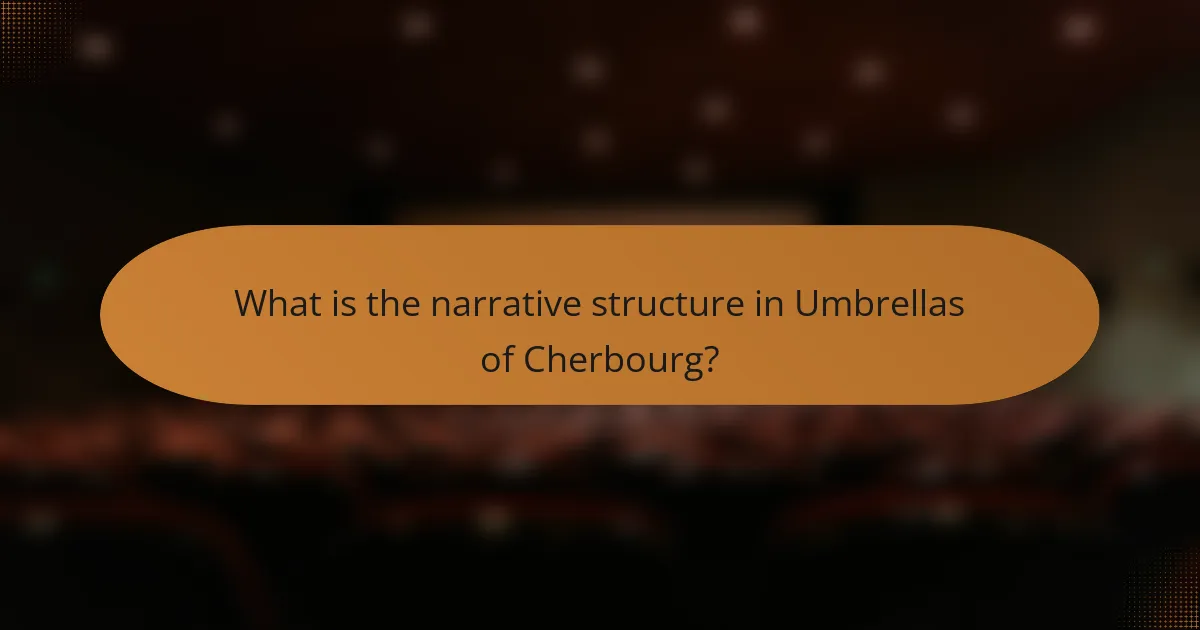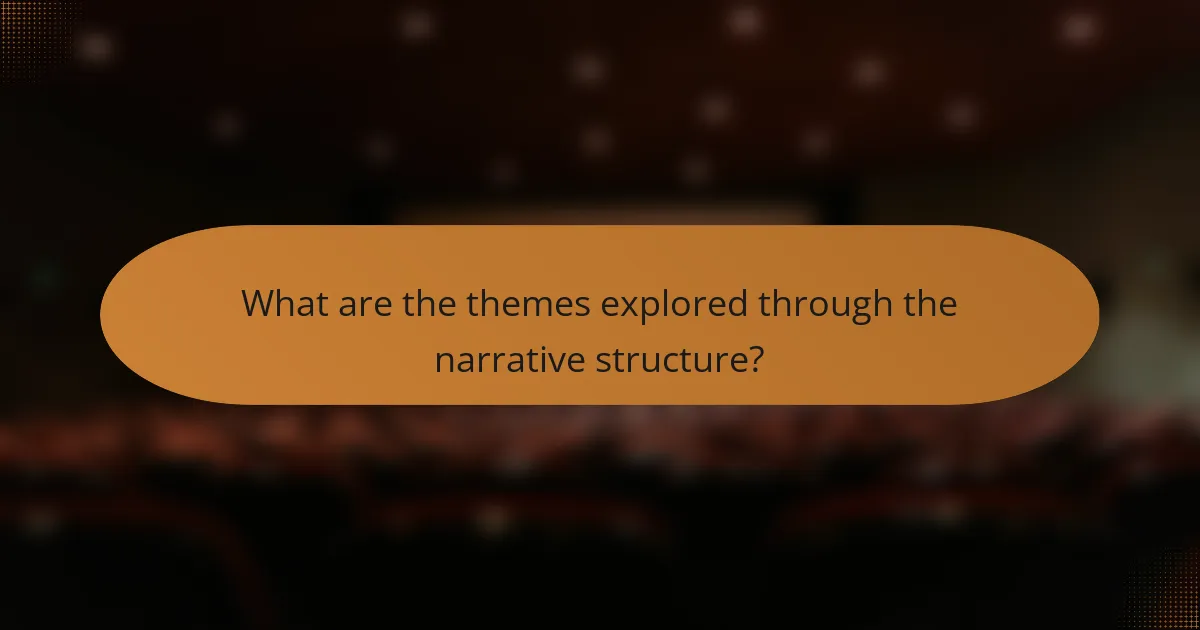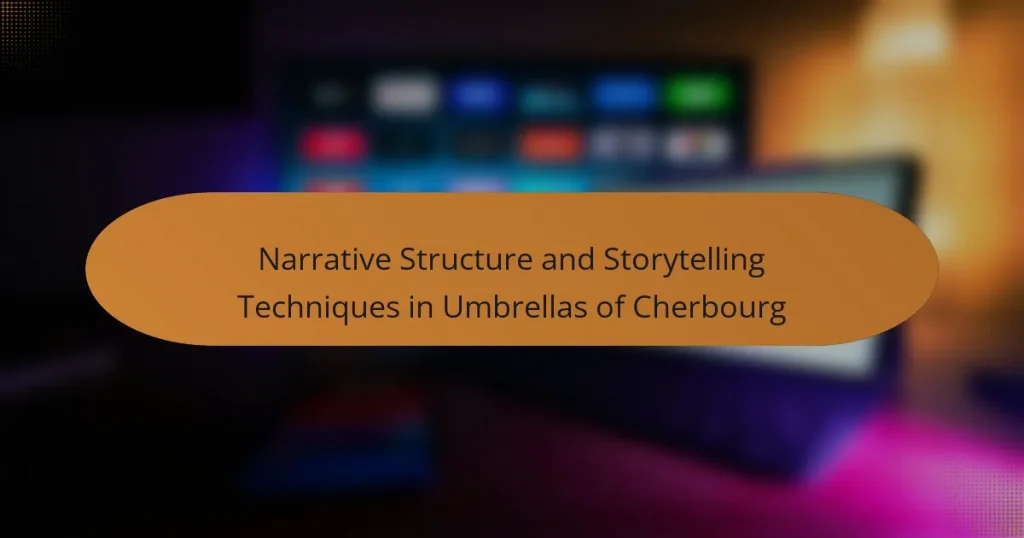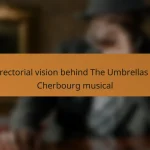The article examines the narrative structure and storytelling techniques utilized in the film “Umbrellas of Cherbourg.” It highlights the linear, chronological timeline that follows the romantic journey of the main characters, Geneviève and Guy, amidst the backdrop of significant life events, including Guy’s conscription into the Algerian War. The film employs musical numbers to convey emotions and advance the plot, with vibrant visuals enhancing the storytelling. Key themes such as love, loss, and the passage of time are explored through the characters’ development and the episodic nature of the narrative. The interaction between character growth and narrative structure is analyzed to illustrate how they collectively engage the audience.

What is the narrative structure in Umbrellas of Cherbourg?
The narrative structure in Umbrellas of Cherbourg is linear and primarily follows a chronological timeline. The film unfolds over a period of time, depicting the lives of the main characters, Geneviève and Guy. Their love story begins with a passionate romance that is interrupted by Guy’s conscription into the Algerian War. The narrative progresses through their separation and the subsequent choices they make.
The story is told through a series of musical numbers, which convey emotions and advance the plot. Each song reflects the characters’ feelings and situations. The use of vibrant colors and visual symbolism enhances the storytelling. The film concludes with a bittersweet resolution, emphasizing themes of love and sacrifice.
Overall, the narrative structure effectively intertwines music and visuals to create an emotional journey. This unique approach to storytelling distinguishes Umbrellas of Cherbourg in the musical genre.
How does the narrative structure influence the storytelling?
Narrative structure significantly influences storytelling by determining the order and presentation of events. It shapes how audiences perceive characters and plot progression. Different structures, such as linear or non-linear, create varying emotional impacts. For example, a linear structure offers a straightforward experience, while a non-linear structure can build suspense and intrigue. In “Umbrellas of Cherbourg,” the use of musical elements as part of the narrative structure enhances emotional depth. This integration allows the audience to connect with characters’ feelings more profoundly. Studies show that narrative structure affects audience engagement and retention of information. Thus, the chosen narrative structure is crucial for effective storytelling.
What are the key components of the narrative structure in the film?
The key components of the narrative structure in the film “Umbrellas of Cherbourg” include exposition, rising action, climax, falling action, and resolution. Exposition introduces the main characters, Geneviève and Guy, and their romantic relationship. Rising action develops their love story amidst external conflicts, such as war and socioeconomic challenges. The climax occurs when Geneviève must choose between love and obligation. Falling action depicts the consequences of her decision, leading to emotional turmoil for both characters. Finally, resolution shows the characters’ lives years later, reflecting on their choices and the passage of time. This structure emphasizes themes of love, sacrifice, and the impact of circumstances on personal relationships.
How does the narrative structure differ from traditional storytelling?
Narrative structure in “Umbrellas of Cherbourg” differs from traditional storytelling by employing a nonlinear approach. Traditional storytelling typically follows a linear progression, with a clear beginning, middle, and end. In contrast, “Umbrellas of Cherbourg” uses a continuous, cyclical narrative that emphasizes emotional experiences over chronological events. The film integrates song as dialogue, which alters the pacing and flow of the story. This method creates a unique atmosphere that focuses on the characters’ feelings rather than plot-driven action. The use of vibrant colors and visual motifs further enhances the emotional depth. This approach distinguishes it from conventional narratives, which rely heavily on dialogue and action to convey the story.
What storytelling techniques are utilized in Umbrellas of Cherbourg?
The storytelling techniques utilized in Umbrellas of Cherbourg include the use of sung dialogue, vibrant color palettes, and non-linear narrative structure. Sung dialogue creates a musical experience that conveys emotions and enhances character interactions. The vibrant color palettes symbolize the characters’ feelings and the mood of the scenes. Non-linear narrative structure allows for flashbacks and forward jumps, deepening the emotional impact of the story. These techniques work together to create a unique cinematic experience that emphasizes themes of love and loss.
How does music play a role in the storytelling techniques?
Music enhances storytelling techniques by conveying emotions and setting the tone. In “Umbrellas of Cherbourg,” the entire narrative is presented as a sung-through musical. This format allows music to express characters’ inner feelings and motivations directly. The melodies and harmonies underscore dramatic moments, creating a deeper emotional connection with the audience. Additionally, musical themes recur throughout the film, reinforcing key narrative elements and character arcs. For instance, the use of specific motifs associated with characters helps to establish their identities and emotional journeys. This integration of music and narrative structure makes the storytelling unique and impactful.
What visual storytelling methods are employed in the film?
The film employs several visual storytelling methods. Color is a significant method used to convey emotions and themes. The vibrant palette reflects the characters’ feelings and the tone of the narrative. Framing and composition are carefully crafted to emphasize the characters’ emotional states. Close-ups are frequently used to capture subtle expressions, enhancing viewer connection. Symbolism is also prevalent, with objects and settings representing deeper meanings. For example, the umbrellas symbolize both protection and the fragility of dreams. Movement and choreography of scenes contribute to the film’s rhythm and emotional impact. These methods collectively create a rich visual narrative that complements the story.

How do character development and narrative structure interact?
Character development and narrative structure interact closely to shape a story’s impact. Character development refers to how characters evolve throughout a narrative. Narrative structure outlines the framework that organizes the events of a story. The progression of characters often drives the narrative forward. As characters face challenges, their decisions influence plot developments. Conversely, the narrative structure can dictate how character arcs unfold. A linear structure may present character growth in a straightforward manner. Non-linear structures can create tension by revealing character motivations gradually. In “Umbrellas of Cherbourg,” character development is intertwined with the musical’s episodic narrative. Each song advances both the plot and the characters’ emotional states. The interaction enhances audience engagement and emotional resonance.
What role do characters play in shaping the narrative structure?
Characters are essential in shaping the narrative structure by driving the plot and influencing thematic elements. They provide motivation and conflict, which are crucial for narrative progression. Their relationships and interactions create dynamics that shape the story’s direction. For instance, in “Umbrellas of Cherbourg,” the characters’ emotional journeys reflect broader themes of love and loss. Their decisions impact the unfolding events, establishing cause-and-effect relationships within the narrative. Characters also serve as vessels for the audience’s emotional engagement, making the story relatable. This connection enhances the overall narrative experience by inviting viewers to invest in the characters’ outcomes.
How does character motivation drive the plot forward?
Character motivation drives the plot forward by influencing decisions and actions. In “Umbrellas of Cherbourg,” characters’ desires and goals shape their interactions. For instance, Geneviève’s motivation to secure a stable future propels her towards making difficult choices. Similarly, Guy’s longing for love and duty impacts his decisions throughout the narrative. Each character’s motivation creates conflict and tension, essential for plot development. The interplay of motivations leads to pivotal moments that advance the storyline. This dynamic illustrates how character motivations are integral to narrative progression.
What unique attributes do the characters bring to the narrative?
The characters in “Umbrellas of Cherbourg” bring unique attributes that enhance the narrative’s emotional depth. Geneviève embodies youthful idealism and longing, driving the story’s romantic tension. Guy represents resilience and sacrifice, showcasing the struggles of love and duty. The shopkeeper, Roland, adds complexity with his pragmatic view of relationships, contrasting with the protagonists’ romanticism. Each character’s distinct motivations and backgrounds contribute to the film’s exploration of love, loss, and the passage of time. Their interactions create a rich tapestry that reflects the bittersweet nature of life and relationships.
How does the setting impact the narrative structure?
The setting significantly impacts the narrative structure by shaping the story’s tone and context. In “Umbrellas of Cherbourg,” the vibrant colors and urban landscape create an emotional backdrop. This backdrop influences character decisions and interactions. The setting also establishes a sense of time, reflecting the socio-economic conditions of the 1960s. For example, the portrayal of the town affects the characters’ aspirations and limitations. Additionally, the setting’s musical elements enhance the storytelling, intertwining visuals with emotional resonance. Overall, the setting is integral to understanding character motivations and narrative progression.
What is the significance of the film’s setting in relation to the story?
The film’s setting in “Umbrellas of Cherbourg” is crucial to the story as it reflects the emotional landscape of the characters. The vibrant colors and picturesque streets of Cherbourg create a backdrop that amplifies the themes of love and loss. The setting enhances the narrative by contrasting the beauty of the town with the characters’ struggles. For instance, the town’s atmosphere mirrors the protagonist’s youthful optimism. As the story unfolds, the setting shifts to represent the characters’ evolving circumstances. The use of real locations adds authenticity to their experiences. The setting also plays a role in emphasizing the passage of time, marking changes in relationships. Overall, the film’s setting is integral to understanding the emotional depth of the narrative.
How does the setting enhance the emotional depth of the narrative?
The setting enhances the emotional depth of the narrative by creating a vivid backdrop that reflects the characters’ inner turmoil. In “Umbrellas of Cherbourg,” the vibrant colors and atmospheric elements of Cherbourg amplify the emotional stakes. The rainy weather symbolizes sadness and longing, mirroring the characters’ struggles. The setting’s historical context adds layers of nostalgia and loss. The use of music intertwined with the setting intensifies the emotional resonance. This combination of visual and auditory elements deepens the audience’s connection to the characters. The specific portrayal of Cherbourg as both beautiful and melancholic creates a unique emotional landscape. Therefore, the setting is integral to the narrative’s emotional complexity.

What are the themes explored through the narrative structure?
The themes explored through the narrative structure of “Umbrellas of Cherbourg” include love, loss, and the passage of time. The film’s unique storytelling technique utilizes a non-linear narrative. This approach emphasizes the emotional weight of the characters’ experiences. The use of song as dialogue further deepens the exploration of these themes. Love is portrayed as both passionate and fleeting. Loss is depicted through separation and longing. The passage of time is illustrated through changing seasons and life events. These elements combine to create a poignant reflection on human relationships.
How do themes of love and loss manifest in the narrative?
Themes of love and loss manifest prominently in the narrative of “Umbrellas of Cherbourg.” The story centers on the passionate romance between Geneviève and Guy. Their love is depicted through vibrant colors and music, symbolizing joy and hope. However, the narrative introduces loss when Guy is drafted into the war. Geneviève’s heartbreak is palpable as she faces the uncertainty of their future together. The passage of time further emphasizes loss, as Geneviève ultimately moves on with her life. The film’s ending underscores the bittersweet nature of love, highlighting how it can lead to both joy and sorrow. The use of song throughout the narrative reinforces emotional depth, making the themes resonate with the audience.
What specific narrative techniques highlight these themes?
The specific narrative techniques that highlight themes in “Umbrellas of Cherbourg” include the use of color symbolism, non-linear storytelling, and musical elements. Color symbolism conveys emotional depth and character development. Each color represents specific feelings or themes, enhancing the narrative’s emotional resonance. Non-linear storytelling allows for exploration of memory and time, creating a reflective atmosphere. This technique emphasizes the characters’ internal struggles and desires. Musical elements integrate dialogue and emotion, transforming spoken words into song. This technique reinforces the themes of love and loss through melodic expression. Together, these techniques create a rich tapestry that deepens the audience’s engagement with the story.
How do these themes resonate with the audience?
The themes in “Umbrellas of Cherbourg” resonate with the audience by evoking deep emotional responses. The film’s exploration of love, loss, and longing reflects universal human experiences. Audiences relate to the characters’ struggles and aspirations, making the narrative impactful. The use of vibrant colors and music enhances emotional engagement. Research shows that emotional storytelling fosters connection, as noted in “The Science of Storytelling” by Will Storr. This connection reinforces the film’s themes, making them memorable for viewers. Overall, the themes effectively resonate due to their relatability and emotional depth.
What can we learn from the narrative structure of Umbrellas of Cherbourg?
The narrative structure of Umbrellas of Cherbourg teaches us about the integration of music and dialogue in storytelling. The film employs a sung-through format, where every line is delivered as a song. This technique creates an emotional depth that traditional dialogue may not achieve. The story unfolds in a linear fashion, emphasizing the passage of time and the impact of decisions on characters’ lives. Flashbacks are minimal, allowing the audience to engage with the characters’ present struggles. The use of color and visual composition enhances the narrative, reflecting characters’ emotions and themes. The structure highlights themes of love, loss, and inevitability, resonating with viewers. Overall, the film demonstrates how narrative structure can shape audience experience and emotional response.
How can these storytelling techniques be applied to other films?
Storytelling techniques from “Umbrellas of Cherbourg” can enhance other films by emphasizing emotional resonance and narrative cohesion. Techniques such as non-linear storytelling and the use of music as a narrative device create a unique viewing experience. These methods engage audiences on a deeper emotional level. For instance, films like “La La Land” utilize similar musical storytelling to convey character emotions and plot progression. Additionally, the visual style and color symbolism in “Umbrellas of Cherbourg” can inspire filmmakers to use visual elements to reflect themes and character arcs. This approach can be seen in films like “The Grand Budapest Hotel,” where color palettes are integral to storytelling. Overall, applying these techniques can lead to more impactful and memorable cinematic experiences.
What best practices can emerging filmmakers draw from this narrative structure?
Emerging filmmakers can draw several best practices from the narrative structure of “Umbrellas of Cherbourg.” First, they should prioritize emotional resonance through character-driven storytelling. This film effectively uses music and color to enhance emotional impact. Second, filmmakers should consider the use of non-linear timelines to create suspense and depth. “Umbrellas of Cherbourg” employs this technique to reveal character backstories gradually. Third, filmmakers can learn the importance of visual storytelling. The film’s vibrant cinematography conveys mood and tone without relying solely on dialogue. Additionally, filmmakers should embrace the concept of unresolved endings to provoke thought and discussion among audiences. This narrative choice encourages viewers to engage with the film on a deeper level. Finally, integrating a unique artistic style can differentiate a filmmaker’s work. “Umbrellas of Cherbourg” is renowned for its distinct visual and musical identity, setting it apart in cinematic history.
The main entity of the article is the narrative structure and storytelling techniques utilized in the film “Umbrellas of Cherbourg.” The article provides a detailed analysis of the film’s linear narrative, which unfolds chronologically and emphasizes the emotional journeys of the characters Geneviève and Guy. It explores how musical elements, vibrant colors, and visual symbolism contribute to the storytelling, enhancing themes of love, loss, and the passage of time. Additionally, the article examines key components of the narrative structure, character development, and the impact of setting on the overall emotional depth of the film.


